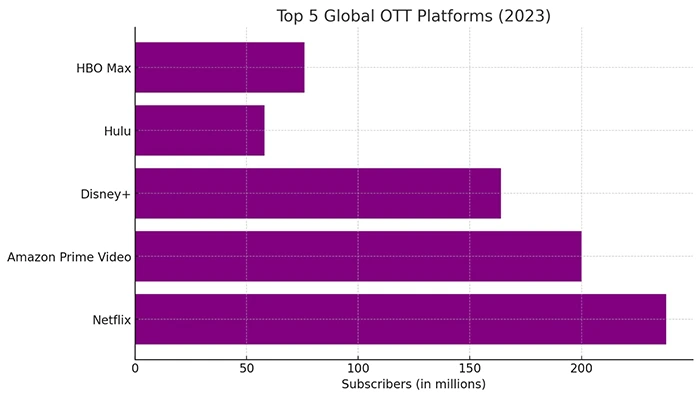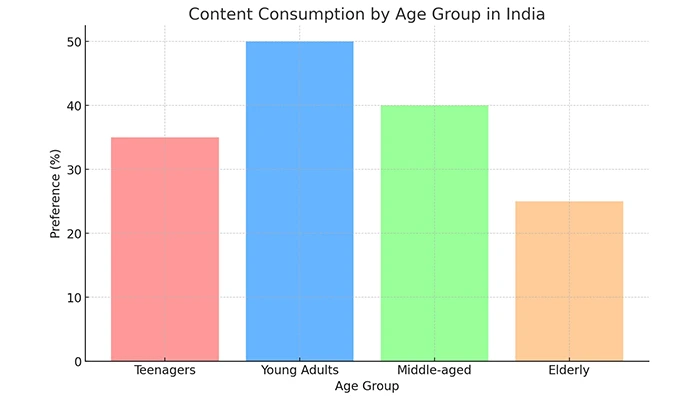The Over-the-Top (OTT) industry has revolutionized the way we consume entertainment, ushering in a new era characterized by on-demand access and diverse content. This transformation has significantly impacted both urban and rural audiences, redefining traditional media consumption and bridging geographic divides. Here’s a detailed exploration of how OTT platforms have reshaped entertainment globally and in India.
Traditional Media Landscape Before OTT
India:
Before OTT platforms, India’s entertainment was primarily dictated by television and cinema. Doordarshan, the state-run broadcaster, was the dominant force, providing limited programming with strict scheduling. Viewers had to plan their leisure activities around broadcast times, leading to a narrow selection of shows and movies.
The 1990s saw the advent of cable TV, which introduced multiple channels and increased viewing options. However, despite this increase, content consumption was still bound by fixed schedules, and multiplexes in urban areas provided more choices that were often out of reach for rural audiences due to economic and geographic barriers.
Global:
Globally, traditional media was similarly constrained. Cable and satellite TV dominated in regions such as the U.S., Europe, and Asia, offering a range of channels but with little flexibility. High subscription costs and a lack of personalized content limited viewers’ options. Cinemas, predominantly located in urban areas, further restricted access for rural populations. Moreover, broadcasting rights often limited the availability of international content, making it difficult for audiences to access a diverse array of programming.

The Emergence of OTT Platforms
Global Perspective:
The mid-2000s marked a turning point with the rise of OTT platforms. These services disrupted traditional media by providing on-demand access to a vast range of content, free from the constraints of linear scheduling and geographic limitations.
- Netflix: Transitioning to streaming in 2007, Netflix has become a leader in the OTT space. With over 238 million subscribers globally as of 2023, Netflix’s extensive content library, including popular originals like Stranger Things and The Crown, has solidified its dominance. The company’s significant investment in original programming and international expansion has further strengthened its market position. (Source: Netflix 2023 Q2 Earnings Report)
- Amazon Prime Video: Launched in 2006, Amazon Prime Video has also become a major player, reaching 200 million subscribers in over 200 countries by 2023. Its diverse content offerings, including acclaimed originals like The Marvelous Mrs. Maisel and The Boys, have contributed to its widespread appeal. The integration with Amazon Prime memberships has further extended its reach. (Source: Amazon 2023 Q2 Financial Report)
- Disney+: Entering the OTT market in November 2019, Disney+ quickly gained traction, amassing 164.2 million subscribers by the end of 2023. Its extensive library, featuring Disney classics, Marvel series, and Star Wars content, has driven its success. (Source: Disney Q4 2023 Earnings Report)
These platforms have not only redefined content consumption but also driven the trend of “cord-cutting,” where viewers shift from traditional cable subscriptions to flexible, on-demand streaming services.

Regional Perspective: India’s OTT Revolution
In India, the OTT revolution began with platforms such as Disney Hotstar (formerly Hotstar), Netflix India, and Amazon Prime Video. The proliferation of affordable data plans, particularly after Reliance Jio’s launch in 2016, was pivotal in accelerating OTT adoption. High-speed internet access became available to millions, including those in rural and semi-urban areas, facilitating wider access to streaming services.
- Disney Hotstar: Dominating the Indian OTT market, Disney Hotstar has over 50 million subscribers. Its comprehensive content library, including significant sports coverage (especially cricket) and Bollywood films, has made it a popular choice among Indian viewers. The platform’s ability to offer live sports events and a broad range of regional programming has contributed to its substantial user base. (Source: FICCI-EY Report 2022)
- Zee5: Zee5 caters to a diverse linguistic audience, offering content in 12 languages. With 80 million monthly active users, Zee5’s focus on regional programming in languages such as Tamil, Telugu, and Marathi has resonated with viewers in tier 1 and tier 2 cities. (Source: Media Partners Asia, 2023)
- MX Player: Operating on an ad-supported model, MX Player boasts over 280 million monthly active users. Its extensive content library, including regional programming and exclusive collections, appeals to a broad audience across various socio-economic segments. The platform’s free-to-use model has played a crucial role in its widespread adoption. (Source: KPMG Report 2023)
The Rise of Niche and Small-Scale OTT Platforms
In addition to major players, India’s OTT landscape features niche platforms catering to specific linguistic and regional audiences:
- Hoichoi: Specializing in Bengali content, Hoichoi has attracted over 15 million subscribers. The platform focuses on Bengali films, web series, and short films, serving audiences in West Bengal and Bangladesh. (Source: Hoichoi’s 2023 Growth Report)
- Aha: Targeting the Telugu-speaking audience, Aha achieved over 10 million downloads within its first year. Its focus on Telugu content and competitive pricing have allowed it to stand out in a crowded market, particularly in Andhra Pradesh and Telangana. (Source: Ormax Media Report 2023)

Post-OTT Boom: The Impact of Streaming Services
India:
The OTT boom has significantly altered entertainment consumption patterns in India. OTT platforms have become mainstream, with increased adoption across urban and rural regions. The COVID-19 pandemic accelerated this shift, with major films like Gulabo Sitabo and Shakuntala Devi debuting directly on streaming platforms, setting new precedents in film distribution.
Global:
Globally, OTT platforms have led to a notable decline in traditional TV viewership, with more consumers opting for streaming services. International hits such as Money Heist from Spain and Squid Game from South Korea have gained worldwide acclaim, illustrating the power of OTT platforms to connect diverse audiences. The intense competition among OTT services has led to significant investments in original content, with Netflix’s $17 billion annual content budget exemplifying the high stakes in the industry.
Growth Statistics: OTT Industry in India and Globally
India:
The Indian OTT market was valued at $2.4 billion in 2021 and is projected to reach $5 billion by 2025 . Major players such as Disney Hotstar, Netflix, Amazon Prime Video, Zee5, and Voot contribute to this rapid growth. The demand for local content has driven this expansion, with platforms like Zee5, Hoichoi, and Aha successfully catering to regional preferences.
Global:
Globally, OTT revenues were $83 billion in 2020 and are expected to surpass $275 billion by 2027 . The significant growth in subscriber numbers for leading platforms like Netflix, Disney+, and Amazon Prime Video underscores the shift towards on-demand streaming. The rise in binge-watching and on-demand content consumption continues to fuel this expansion.

Key Regional Comparisons
India vs. Global
Content production in India differs markedly from international markets due to the country’s linguistic and cultural diversity. Indian platforms focus heavily on regional and Bollywood content, whereas global platforms offer a broader range of genres, from anime in Japan to K-dramas in South Korea.
Revenue models also vary: India sees a mix of freemium and ad-supported models (e.g., YouTube, Hotstar), while global markets predominantly use subscription-based models. Mobile streaming is particularly prominent in India, driven by affordable 4G services, whereas international markets feature a balance between TV, computer, and mobile streaming.
Content Preferences
In India, younger audiences are drawn to animated series and youth-oriented dramas, while adults favor Bollywood films and local dramas. The growing popularity of niche genres, such as true crime, reflects an evolving appetite for diverse content. Globally, content preferences vary widely, with anime popular in Japan, K-dramas in Korea, and true crime series in the U.S. The OTT industry’s ability to cater to diverse tastes is a testament to its adaptability.
Future Trends and Predictions
India:
The future of OTT in India is bright, with expected growth driven by increased regional content, enhanced investment in original programming, and technological advancements like interactive content and virtual reality. The rollout of 5G technology is likely to further boost OTT adoption, improving streaming quality and enabling more immersive content experiences.
Global:
Globally, OTT is set to continue expanding, with emerging markets in Southeast Asia and Africa offering new growth opportunities. The development of interactive and immersive content, including virtual and augmented reality, will shape the future of OTT. Ongoing consolidation within the industry, with major players acquiring smaller platforms, will diversify content offerings and strengthen market positions. The focus on global content distribution will further influence the evolution of the OTT landscape.

Conclusion
The OTT industry has profoundly transformed entertainment by providing viewers with unprecedented flexibility, affordability, and content diversity. This shift from traditional media to on-demand streaming has empowered audiences, offering access to a wide range of content across languages and cultures. As the OTT industry continues to evolve, it will further redefine entertainment, meeting growing consumer expectations and shaping the future of media consumption.

